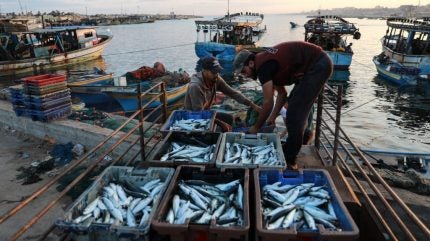

One of the SDG14 targets is to protect small fishing businesses. (Photo by Majdi Fathi/NurPhoto via Getty Images)
Investing in oceans and marine resources could provide investors with an opportunity to diversify their portfolios and generate higher returns on their investments. However, for this to happen a blue wave of sustainable investment in fisheries and the ocean economy will be needed in the post-pandemic world.
This is where the UN’s 14th Sustainable Development Goal (SDG), which concerns conserving and sustainably using the oceans, seas and marine resources, comes in.
More specifically, SDG14 outlines a set of targets to protect marine ecosystems, reduce acidification of the world’s oceans and rivers, and ensure that small-scale fishermen and women have access to marine resources and markets. Other SDG14 targets include regulating harvesting and fishing to restore fish stocks, the sustainable management of fisheries, aquaculture and tourism, and introducing special and differential treatment for developing countries in World Trade Organisation negotiations on fishing subsidies.
The oceans have been mistreated for years, as marine life suffers and pollution levels in the water continue to rise. Can foreign direct investment (FDI) and SDG14 combine to reverse this decline while maintaining the economic viability of the industries connected with life under water?
Which locations face the most risks?
The global contribution of the ‘ocean economy’ is estimated to be about $3.6trn a year and provides more than 150 million jobs. Given these figures, it is clear why so many are keen to preserve this economy and promote sustainable development, climate action and the reduction of ocean sustainability risks. On top of the ecological good that can be done, there are profits to be preserved.
Research by Investment Monitor reveals that there are many countries facing ocean sustainability challenges across the world. More specifically, the Ocean Sustainability Risk Index reveals that the 31 countries face high risks, 84 face medium risks, and 25 low risks.
China is the country facing the biggest ocean sustainability risks. Other countries scoring highly include Taiwan, Cambodia, Russia and Vietnam, according to the index.
Which FDI projects can help to achieve SDG14's targets?
Fred Sullivan of the World Ocean Council believes that for FDI flows to help in achieving the targets of SDG14, all sectors must work hand in hand to promote sustainable development and climate action.
He says it is essential that there is a holistic approach towards embracing environmental, social, and governance criteria among companies that operate in different sectors, with them backing investment opportunities in several areas in order to achieve the SDG14 targets.
According to the UN's SDG Investor Platform, investment opportunities that could help to reach the targets of SDG14 fall in:
- Fish breeding
- Feedstock from food waste
- Fishery terminals
- Sustainable fish production
- Land-based aquaculture
- Coastal aquaculture
- Production of freshwater fish in sustainable aquaculture farms
- Wastewater treatment facilities and technologies
- Cold storage port facilities for agricultural produce
- Digital platforms to service input needs of farmers and provide them with easy access to markets
- Distributed community solar generation technology
- Ecology and ecotourism
- Recycling facilities
- Electronic waste recycling
Which industries dominate the ocean economy?
While there are several sectors that investors could target in order to embrace sustainability in the ocean economy, data shows that there is a long way to go before this will be achieved.
More specifically, a research article by the scientific journal Science Advances states that “the ocean economy is growing as commercial use of the ocean accelerates, while progress toward achieving international goals for ocean conservation and sustainability is lagging”.
The article adds that there is a high concentration of transnational corporations operating in the ocean economy across eight industries, which poses a challenge to achieving the targets of SDG14. The eight industries are offshore oil and gas, container shipping, shipbuilding and repair, maritime equipment and construction, seafood production, cruise tourism, offshore wind and port operations.
What’s more, when aggregating across all eight industries, the 100 largest corporations account for 60% of total revenues. The article states that “this level of concentration in the ocean economy presents both risks and opportunities for ensuring sustainability and equity of global ocean use”.
Are our oceans awash with opportunity
FDI flows towards the ocean economy need to increase in order to 'build back better' and achieve the levels of sustainability required, especially in developing economies, according to Sullivan. He adds that the Covid-19 pandemic has led to a drop in official and private development assistance, which has negatively impacted FDI flows.
Data from the UN Conference on Trade and Development (UNCTAD) shows that global FDI flows dropped by 35% in 2020, to about $1trn from $1.5trn in 2020. However, the UNCTAD World Investment Report 2021 states that flows will “bottom out in 2021 and recover some lost ground with an increase of 10% to 15%” by the end of the year.
It is essential that any increase in FDI flows comes alongside an appetite for sustainable development, especially for projects linked to ocean-related sectors. This would lead to not only transfer of technology and economic growth in the host countries, but could also waterproof investors’ businesses from future disruptive events, all while working towards the SDG14 targets.
This is one of the articles in Investment Monitor’s 'SDG Focus' series. The full list of articles is listed below.
- SDG1 – poverty
- SDG2 – hunger
- SDG3 – health
- SDG4 – education
- SDG5 – gender
- SDG6 – water
- SDG7 – energy
- SDG8 – employment
- SDG9 – infrastructure
- SDG10 – inequality
- SDG11 – sustainable cities
- SDG12 – responsible production and consumption
- SDG13 – climate change
- SDG14 – life under water
- SDG15 – life on land
- SDG16 – peace, justice and strong institutions
- SDG17 – partnerships



